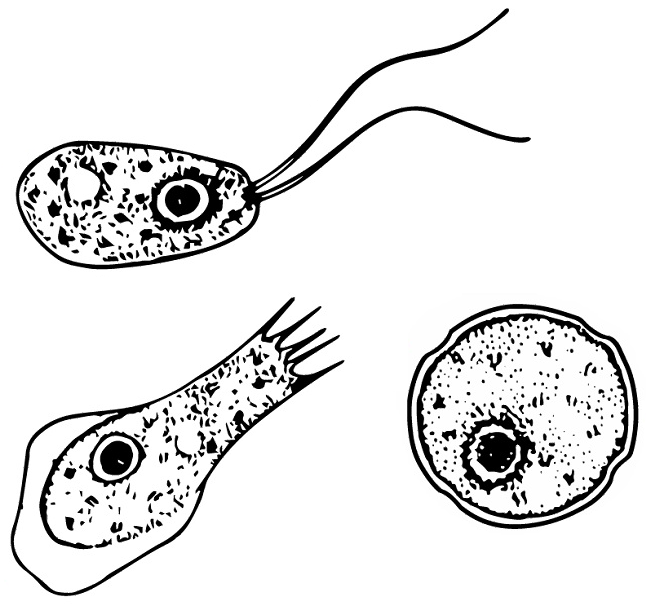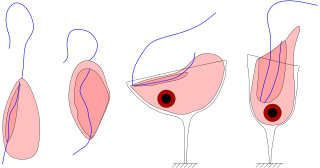
The Apicomplexa are a large phylum of parasitic alveolates. Most of them possess a unique form of organelle that comprises a type of plastid called an apicoplast, and an apical complex structure. The organelle is an adaptation that the apicomplexan applies in penetration of a host cell.

The Percolozoa are a group of colourless, non-photosynthetic Excavata, including many that can transform between amoeboid, flagellate, and cyst stages.

The alveolates are a group of protists, considered a major clade and superphylum within Eukarya, and are also called Alveolata.

The chlorarachniophytes are a small group of exclusively marine algae widely distributed in tropical and temperate waters. They are typically mixotrophic, ingesting bacteria and smaller protists as well as conducting photosynthesis. Normally they have the form of small amoebae, with branching cytoplasmic extensions that capture prey and connect the cells together, forming a net. They may also form flagellate zoospores, which characteristically have a single subapical flagellum that spirals backwards around the cell body, and walled coccoid cells.

Cercomonads are small flagellates, widespread in aqueous habitats and common in soils.
Gymnophryidae is a small family of amoeboids that lack shells and produce thin, reticulose pseudopods. These contain microtubules and have a granular appearance, owing to the presence of extrusomes, but are distinct from the pseudopods of Foraminifera. They are included among the Cercozoa, but differ from other cercozoans in having mitochondria with flat cristae, rather than tubular cristae.

Monadofilosa is a grouping of Cercozoa. These organisms are single-celled amoeboid protists.

Phalansterium is a genus of single-celled flagellated organisms comprising several species, which form colonies. Phalansterium produces tetraspores.
Carpediemonas is genus of Metamonada, and belongs to the group Excavata. This organism is a unicellular flagellated eukaryote that was first discovered in substrate samples from the Great Barrier Reef. Carpediemonas can be found in anaerobic intertidal sediment, where it feeds on bacteria. A feature of this species is the presence of a feeding groove, a characteristic of the excavates. Like most other metamonads, Carpediemonas does not rely on an aerobic mitochondria to produce energy. Instead, it contains hydrogenosomes that are used to produce ATP. This organism has two flagella: a posterior one used for feeding on the substrate, and an anterior one that moves in a slower sweeping motion. Carpediemonas is assigned to the fornicates, where similar Carpediemonas-like organisms are used in researching the evolution within excavates. Although Carpediemonas is a member of the metamonads, it is unusual in the sense that it is free-living and has three basal bodies.
Trimastix is a genus of excavates, the sole occupant of the order Trimastigida. Trimastix are bacterivorous, free living and anaerobic. When first observed in 1881 by William Kent, the morphology of Trimastix was not well described but over time the oral structure and flagellar organization have become clearer. There are few known species, and the genus's role in the ecosystem is largely unknown. However, it is known that they generally live in marine environments within the tissues of decaying organisms to maintain an anoxic environment. Much interest in this group is related to its close association with other members of Anaeromonadea. Like other members of this order, these organisms do not have classical mitochondria. As such, much of the research involving these microbes is aimed at investigating the evolution of mitochondria.

Jakobids are an order of free-living, heterotrophic, flagellar eukaryotes in the supergroup Excavata. They are small, and can be found in aerobic and anaerobic environments. The order Jakobida, believed to be monophyletic, consists of only twenty species at present, and was classified as a group in 1993. There is ongoing research into the mitochondrial genomes of jakobids, which are unusually large and bacteria-like, evidence that jakobids may be important to the evolutionary history of eukaryotes.
Myzozoa is a grouping of specific phyla within Alveolata, that either feed through myzocytosis, or were ancestrally capable of feeding through myzocytosis.

The ciliates are a group of protozoans characterized by the presence of hair-like organelles called cilia, which are identical in structure to eukaryotic flagella, but are in general shorter and present in much larger numbers, with a different undulating pattern than flagella. Cilia occur in all members of the group and are variously used in swimming, crawling, attachment, feeding, and sensation.

The Apusomonadida are a group of protozoan zooflagellates that glide on surfaces, and mostly consume prokaryotes. They are of particular evolutionary interest because they appear to be the sister group to the Opisthokonts, the clade as that includes both animals and fungi. Together with the Breviatea, these form the Obazoa clade.
Rastrimonas is a monotypic genus of parasitic alveolates in the phylum Apicomplexa. It contains the single species Rastrimonas subtilis. It was described in 2002 from the free-living cryptomonad Chilomonas paramaecium and placed in the new genus Cryptophagus. The following year this was renamed Rastrimonas.
Voromonas is a genus of predatory alveolates. The genus and species were described by Mylnikov in 2000. It was originally described as Colpodella pontica but was later renamed by Cavalier-Smith and Chao in 2004.
Parvilucifera is a genus of marine alveolates that parasitise dinoflagellates. Parvilucifera is a parasitic genus described in 1999 by Norén et al. It is classified perkinsozoa in the supraphylum of Alveolates. This taxon serves as a sister taxon to the dinoflagellates and apicomplexans. Thus far, five species have been described in this taxon, which include: P.infectans, P.sinerae, P.corolla, P.rostrata, and P.prorocentri. The genus Parvilucifera is morphologically characterized by flagellated zoospore. The life cycle of the species in this genus consist of free-living zoospores, an intracellular stage called trophont, and asexual division to form resting sporangium inside host cell. This taxon has gained more interest in research due to its potential significance in terms of negative regulation for dinoflagellates blooms, that have proved harmful for algal species, humans, and the shellfish industry.
Acrocoelus is a genus of alveolates.

Chilomastix is a genus of pyriform excavates within the family Retortamonadidae All species within this genus are flagellated, structured with three flagella pointing anteriorly and a fourth contained within the feeding groove. Chilomastix also lacks Golgi apparatus and mitochondria but does possess a single nucleus. The genus parasitizes a wide range of vertebrate hosts, but is known to be typically non-pathogenic, and is therefore classified as harmless. The life cycle of Chilomastix lacks an intermediate host or vector. Chilomastix has a resistant cyst stage responsible for transmission and a trophozoite stage, which is recognized as the feeding stage. Chilomastix mesnili is one of the more studied species in this genus due to the fact it is a human parasite. Therefore, much of the information on this genus is based on what is known about this one species.
Colponema is a genus of single-celled flagellates that feed on eukaryotes in aquatic environments and soil. The genus contains 6 known species and has not been thoroughly studied. Colponema has two flagella which originate just below the anterior end of the cell. One extends forwards and the other runs through a deep groove in the surface and extends backwards. Colponema is a predator that feeds on smaller flagellates using its ventral groove. Like many other alveolates, they possess trichocysts, tubular mitochondrial cristae, and alveoli. It has been recently proposed that Colponema may be the sister group to all other alveolates. The genus could help us understand the origin of alveolates and shed light on features that are ancestral to all eukaryotes.










